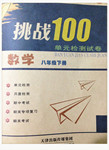题目内容
Try to be independent, for your parents can't do ________ for you all your life.
A. something B. nothing
C. everything D. anything
练习册系列答案
 挑战100单元检测试卷系列答案
挑战100单元检测试卷系列答案
相关题目
题目内容
Try to be independent, for your parents can't do ________ for you all your life.
A. something B. nothing
C. everything D. anything
 挑战100单元检测试卷系列答案
挑战100单元检测试卷系列答案